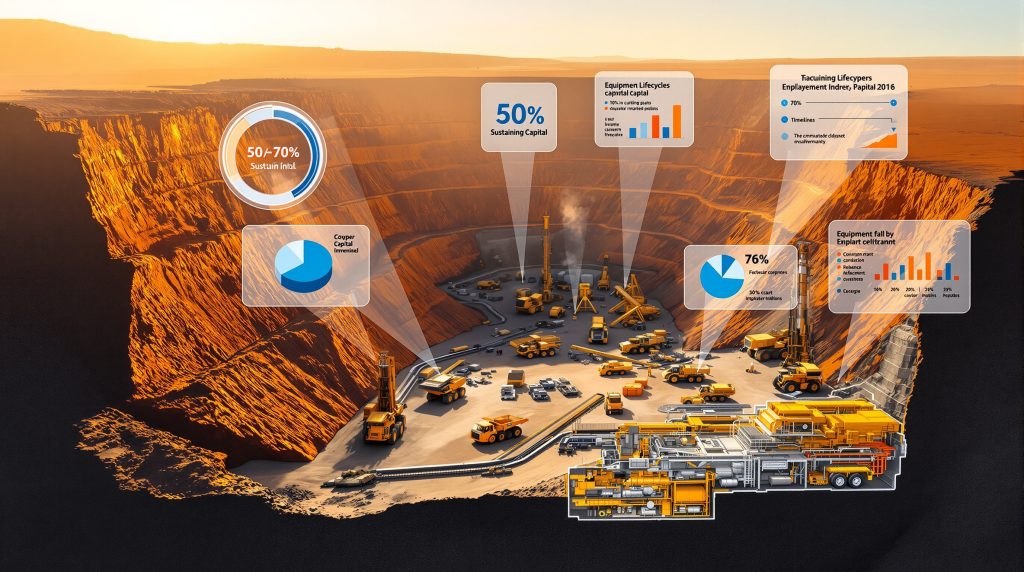Understanding the Foundation of Mining Operations
Sustaining capital represents the financial cornerstone that keeps mining operations running smoothly, encompassing all investments necessary to maintain current production levels and ensure equipment continues functioning effectively. This category of spending differs fundamentally from growth capital, focusing on preserving existing operational capacity rather than expanding it.
The mining industry allocates substantial portions of annual capital expenditures to these maintenance-focused investments, with many companies dedicating 50% or more of their total capital spending to sustaining operations. This significant financial commitment reflects the capital-intensive nature of mining and the continuous battle against equipment degradation, geological challenges, and evolving regulatory requirements.
Research from industry analysts reveals that mining companies typically experience significant volatility in their sustaining capital in mining spending, with annual expenditures swinging 20% above or below budgeted amounts. One global mining company tracked over a five-year period demonstrated this challenge, achieving 80% compliance rates for large projects while smaller initiatives fell to just 40% compliance.
Key Distinctions in Mining Capital Allocation
The fundamental difference between sustaining and growth capital lies in their strategic objectives and operational focus. Sustaining capital investments target operational continuity and asset preservation, while growth capital pursues production capacity expansion and market entry opportunities.
Sustaining Capital Characteristics:
- Equipment replacement and major mechanical overhauls
- Infrastructure maintenance and regulatory upgrades
- Safety system enhancements and monitoring equipment
- Environmental management system improvements
- Compliance-driven facility modifications
Growth Capital Focus Areas:
- Production capacity expansion projects
- New mine development and exploration
- Market entry initiatives and geographic expansion
- Technology adoption for increased operational output
- Strategic acquisition integration
| Investment Aspect | Sustaining Capital | Growth Capital |
|---|---|---|
| Project Duration | 3-18 months | 2-10 years |
| Planning Cycle | Annual/Biennial | 5-20 years |
| Risk Profile | Operational continuity | Market expansion |
| Return Measurement | Cost avoidance | Revenue generation |
| Decision Complexity | Maintenance scheduling | Strategic positioning |
The distributed nature of sustaining capital creates unique management challenges, with companies managing hundreds or thousands of expenditures ranging from $100 million waste management projects to $100,000 equipment replacements.
Essential Elements of Sustaining Capital Investment
Mining operations require continuous investment across multiple interconnected infrastructure categories to maintain operational effectiveness and regulatory compliance. These investments span mechanical systems, environmental controls, safety infrastructure, and community relations.
Equipment and Infrastructure Maintenance
Heavy machinery represents the most visible component of sustaining capital, requiring regular mechanical overhauls and eventual complete replacement. Haul trucks, excavators, crushers, and conveyor systems operate under extreme conditions that accelerate wear patterns and necessitate proactive maintenance strategies.
Critical Equipment Categories:
- Mobile fleet maintenance (haul trucks, excavators, loaders)
- Processing equipment overhauls (crushers, mills, flotation cells)
- Transportation infrastructure (conveyor systems, road maintenance)
- Utilities infrastructure (power distribution, water systems)
- Fuel storage and distribution networks
Environmental and Regulatory Compliance Systems
Modern mining operations allocate approximately 10-15% of total capital expenditures to environmental initiatives, driven by increasingly stringent regulatory requirements and stakeholder expectations. These investments encompass water treatment facilities, emissions reduction technology, and ecosystem restoration programs.
Environmental Investment Categories:
- Advanced water treatment and recycling systems
- Air quality monitoring and emissions control equipment
- Waste rock management infrastructure development
- Tailings dam reinforcement and monitoring systems
- Mine reclamation innovations program implementation
Safety and Risk Management Infrastructure
Workplace safety investments form a critical component of sustaining capital, typically representing ongoing commitments to worker protection and operational risk mitigation. These systems require regular updates to meet evolving safety standards and incorporate technological advances.
Industry Insight: Mining companies increasingly recognise that safety investments provide both regulatory compliance and operational efficiency benefits, reducing lost-time incidents and improving workforce productivity.
Common Challenges in Sustaining Capital Management
Mining companies frequently struggle with sustaining capital in mining execution due to organisational structure limitations, planning inefficiencies, and coordination difficulties across distributed operations. Research indicates that 60% of budgeted projects fail to launch on time, while 75% of executed projects represent unplanned, reactive responses rather than strategic initiatives.
Fragmented Decision-Making Structures
Traditional sustaining capital management suffers from decentralised planning approaches where individual mine sites make investment decisions without comprehensive enterprise visibility. This organisational fragmentation produces several cascading problems:
- Inconsistent project prioritisation criteria across sites
- Duplicated procurement efforts without coordination benefits
- Limited economies of scale in supplier negotiations
- Poor enterprise-wide visibility into total capital commitments
- Reactive maintenance culture rather than predictive planning
Budget Forecasting and Execution Gaps
The volatility in sustaining capital spending reflects deeper challenges in forecasting accuracy and project readiness. Companies often rely on reactive, site-driven requests rather than strategic, long-term asset planning approaches.
Execution Challenge Statistics:
- ±20% annual variance from budgeted sustaining capital amounts
- 40% compliance rate for smaller maintenance projects
- 80% compliance rate for larger infrastructure projects
- 75% of executed projects were unplanned responses to equipment failures
Coordination and Visibility Limitations
The distributed nature of sustaining capital creates information silos that prevent effective resource allocation and strategic oversight. Different mine sites may use disparate project management systems, creating data fragmentation that limits enterprise-wide capital optimisation.
Proven Strategies for Sustaining Capital Excellence
Leading mining organisations implement systematic approaches that balance operational autonomy with enterprise-wide coordination, achieving better budget predictability and execution outcomes. Industry research identifies seven core practices that distinguish high-performing sustaining capital programmes.
Balanced Governance Frameworks
Effective organisations balance central oversight with operational flexibility by establishing clear decision-making authority frameworks. Central teams manage high-value, complex projects requiring specialised expertise, while regional operations handle routine maintenance suited to local knowledge and day-to-day operational understanding.
Governance Implementation Elements:
- Clear authority thresholds defining central vs. site decision-making
- Standardised project evaluation and prioritisation criteria
- Cross-functional planning workshops for pipeline development
- Monthly performance tracking dashboards and reporting
- Centralised contingency fund management with defined allocation triggers
Strategic Asset Planning Integration
Best-in-class organisations recognise that 50-70% of sustaining capital needs follow predictable patterns based on equipment lifecycles and operational demands. Linking annual budgets to comprehensive life-of-asset plans improves forecasting accuracy and enables proactive maintenance scheduling.
Asset Planning Components:
- Equipment procurement and installation timeline documentation
- Preventive maintenance schedules based on manufacturer specifications
- Component replacement cycle predictions from operational wear analysis
- Infrastructure degradation pattern modelling
- Regulatory compliance requirement evolution forecasting
Value-Focused Project Prioritisation
Research demonstrates that approximately 80% of sustaining capital spending typically originates from 20-30% of projects, enabling focused management attention on high-impact investments. This concentration principle allows organisations to apply detailed oversight to major expenditures while maintaining operational flexibility for routine maintenance.
Key Finding: Organisations that concentrate detailed budgeting and performance tracking on top-tier projects while maintaining flexible site-level budgets for smaller initiatives achieve better overall execution outcomes.
Dynamic Budget Reallocation Capabilities
Traditional rigid budgeting approaches fail to accommodate changing operational priorities and project readiness fluctuations. Advanced companies maintain centralised contingency funds for strategic projects while enabling site-level budget flexibility for routine maintenance activities.
Reallocation Framework Features:
- Central fund management for largest strategic projects
- Site-level budget pools for routine maintenance flexibility
- Quarterly reallocation reviews based on project readiness
- Unused fund redistribution to cover delays and scope changes
- Performance-based budget adjustment mechanisms
Performance Measurement and Accountability Systems
Effective sustaining capital management requires comprehensive measurement systems that track both financial performance and operational outcomes. The mining industry increasingly adopts standardised metrics to enable cross-company benchmarking and performance improvement initiatives.
All-In Sustaining Cost (AISC) Framework
The mining industry, particularly precious metals producers, utilises AISC methodology to provide comprehensive cost transparency that includes sustaining capital expenditures alongside operational costs. This standardised approach encompasses:
- Direct production costs and labour expenses
- Sustaining capital expenditures for equipment and infrastructure
- Exploration expenses for resource replacement
- Corporate overhead allocation and administrative costs
- Site reclamation and closure provisions
Operational Performance Indicators
Financial Metrics:
- Budget variance percentage tracking across project categories
- Cost per tonne of production maintained through sustaining investments
- Return on sustaining investment calculations
- Capital efficiency ratios comparing input costs to output maintenance
Execution Metrics:
- Equipment availability rates following maintenance investments
- Unplanned maintenance incident frequency reduction
- Project completion timeline adherence rates
- Safety performance indicators and incident reduction trends
Implementation Success Measurement
Case studies demonstrate measurable improvements from systematic sustaining capital management implementation. Organisations applying disciplined approaches achieve visibility into approximately 80% of sustaining capital spending, improved budget compliance, and better alignment of capital allocation with strategic operational priorities.
Environmental, Social, and Governance Integration
Modern sustaining capital decisions increasingly incorporate ESG considerations, driven by regulatory requirements, stakeholder expectations, and long-term operational sustainability concerns. Mining companies allocate growing portions of sustaining capital to environmental protection, community engagement, and governance system improvements.
Environmental Investment Requirements
Mining operations face expanding environmental compliance requirements that necessitate ongoing capital investment in pollution control, ecosystem protection, and resource conservation systems. Furthermore, these investments typically represent 10-15% of total capital expenditures and continue growing as regulations become more stringent.
Environmental Investment Categories:
- Renewable energy infrastructure for reduced carbon emissions
- Advanced water recycling and treatment facility upgrades
- Air quality monitoring and emissions reduction system installation
- Ecosystem restoration and biodiversity offset programme implementation
- Waste minimisation and circular economy initiative development
Community Relations and Social Investment
Social licence maintenance requires ongoing capital investment in community infrastructure, workforce development, and stakeholder engagement facilities. These investments typically represent 3-7% of total capital expenditures in regions with significant local populations, reflecting the importance of community support for operational continuity.
Social Investment Areas:
- Community infrastructure development and maintenance
- Local workforce training programme facilities and equipment
- Cultural heritage protection measures and site preservation
- Stakeholder engagement centre construction and operation
- Healthcare and education facility support in remote locations
Governance and Transparency Systems
Regulatory compliance and stakeholder transparency systems, while representing 1-3% of capital expenditures, prove increasingly critical for maintaining operational licences and stakeholder trust. These investments support data collection, reporting, and communication systems required for modern mining operations.
Technology Transformation in Capital Management
Digital transformation initiatives reshape how mining companies plan, execute, and monitor sustaining capital investments. Advanced analytics, predictive maintenance systems, and integrated asset management platforms enable more strategic and efficient capital allocation decisions.
Digital Asset Management Integration
Modern mining operations leverage comprehensive software platforms that integrate equipment performance monitoring, maintenance scheduling, and replacement planning into unified management systems. However, implementing digital asset management systems enables:
- Real-time equipment condition monitoring and performance tracking
- Predictive maintenance algorithms for optimal replacement timing
- Automated work order generation based on predetermined maintenance triggers
- Cross-site performance analytics and benchmarking capabilities
- Integrated financial planning and budget allocation optimisation
Data-Driven Decision Making Evolution
Advanced analytics help mining companies transition from reactive maintenance approaches to predictive strategies that reduce total cost of ownership while improving operational reliability. Machine learning algorithms analyse equipment performance patterns to optimise maintenance timing and resource allocation.
Technology Implementation Benefits:
- Reduced unplanned equipment downtime through predictive maintenance
- Improved spare parts inventory management and procurement timing
- Enhanced budget forecasting accuracy through historical performance analysis
- Better supplier relationship management through demand prediction
- Optimised resource allocation across multiple site locations
Emerging Trends and Future Considerations
The sustaining capital in mining landscape continues evolving as mining companies adapt to changing stakeholder expectations, technological capabilities, and regulatory requirements. Several key trends are reshaping how organisations approach maintenance and infrastructure investment strategies.
Increased ESG Integration Requirements
Environmental, social, and governance considerations increasingly drive sustaining capital allocation decisions as stakeholders demand greater sustainability and transparency from mining operations. Companies anticipate growing portions of sustaining capital directed toward environmental protection, community engagement, and governance system improvements.
Automation and Remote Operations Investment
Investment in autonomous equipment and remote monitoring systems reshapes sustaining capital priorities, requiring new skills development and maintenance approaches while potentially reducing long-term operational costs through improved efficiency and safety outcomes.
Supply Chain Resilience Enhancement
Recent global supply chain disruptions highlight the importance of operational independence and supplier diversification. Mining companies increasingly allocate sustaining capital toward supply chain resilience, including local sourcing capabilities, strategic inventory management, and backup supplier relationship development.
Regulatory Evolution and Compliance Adaptation
Evolving environmental and safety regulations continue expanding sustaining capital requirements, particularly in areas of emissions reduction, waste management, and worker protection. Companies must anticipate regulatory changes and proactively invest in compliance infrastructure to avoid operational disruptions.
Future Investment Focus Areas:
- Carbon capture and storage technology implementation
- Advanced waste processing and circular economy systems
- Worker safety technology and monitoring system upgrades
- Biodiversity protection and ecosystem restoration programme expansion
- Water conservation and recycling system enhancement
Building Operational Excellence Through Strategic Capital Management
Effective sustaining capital management represents a critical competitive advantage that enables mining operations to achieve better reliability, regulatory compliance, and long-term profitability. Organisations implementing disciplined, strategic approaches to these investments consistently outperform companies relying on reactive, fragmented management systems.
The transformation from reactive maintenance to integrated strategic asset management requires organisational commitment, technological investment, and cultural adaptation toward proactive planning. However, the benefits including improved budget predictability, enhanced operational efficiency, and stronger stakeholder relationships justify the effort required for systematic implementation.
As mining operations face increasing complexity from regulatory requirements, community expectations, and market volatility, sustaining capital in mining excellence becomes not merely an operational necessity but a strategic imperative for long-term competitive success. Companies that master this discipline position themselves for sustained operational performance in an increasingly challenging global mining environment.
The integration of digital technologies, ESG considerations, and stakeholder engagement requirements continues expanding the scope and complexity of sustaining capital decisions. Furthermore, modern mine planning approaches that consider industry evolution trends alongside energy transition strategies will enable organisations to develop comprehensive frameworks for managing these diverse requirements while maintaining operational flexibility and financial discipline, ultimately achieving superior performance outcomes in the evolving mining industry landscape. Companies that successfully implement these comprehensive capital management strategies position themselves for sustained operational excellence and competitive advantage.
Ready to Capitalise on Mining Investment Opportunities?
Discovery Alert's proprietary Discovery IQ model delivers real-time alerts on significant ASX mineral discoveries, instantly empowering subscribers to identify actionable opportunities in mining and exploration companies ahead of the broader market. Begin your 30-day free trial today and secure your market-leading advantage in the dynamic world of mining investments.




